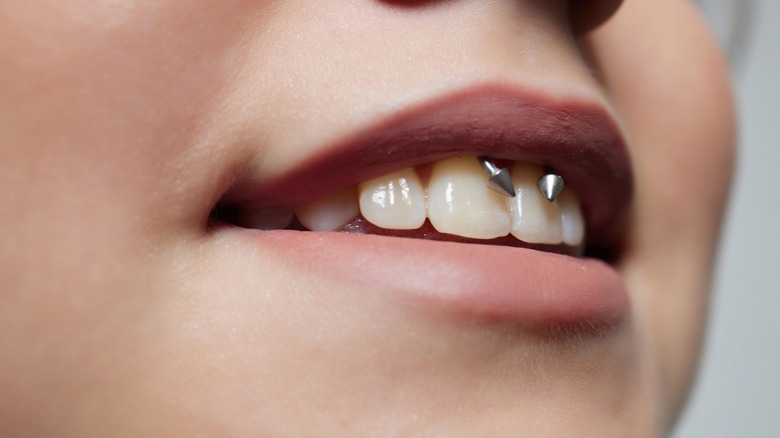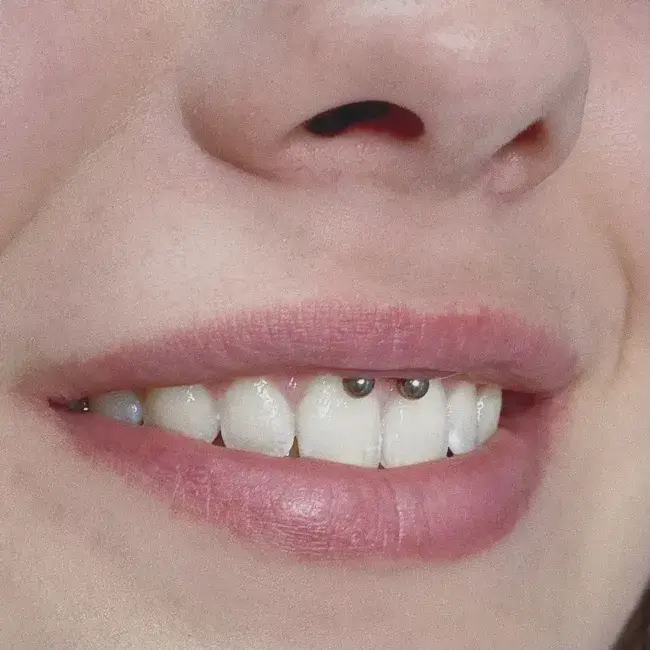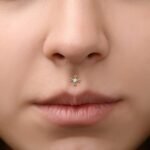The frenulum of the upper lip is pierced to create a smiley piercing. This is the tiny fold of skin that connects the upper lip to the gum. A lot of people, especially young individuals, get this piercing done these days. The Association of Professional Piercers found that smiley piercings were among the top 10 most commonly requested piercings.
However common, smiling piercing is not without its own hazards and concerns. Before getting this pierced, you should learn about the risks and aftercare instructions. A smiley face piercing may seem risky, but with the right maintenance and periodic checkups, it can heal beautifully and become a trendy part of one’s personal style.
Origin of Smiley Piercing

The smiley piercing is thought to have begun in the late 1990s or early 2000s among the subculture of people who get their bodies pierced. It gained popularity as a less obvious option for lip adornment when traditional piercings lost favour.
Initially, captive bead rings or circular barbells were the most popular jewelry choices for smiling piercings, but as the style gained popularity, labrets and horseshoe barbells began to replace them. The smiley face piercing has become a standard in the world of body piercing, and it is still frequently selected by those looking for something different and stylish to add to their bodies.
The smiley face piercing has only been around for a short amount of time, but it has already become a cultural icon representing uniqueness, expression, and defiance. The smiling face piercing has become an increasingly popular and adaptable form of body art, whether for aesthetic or expressive purposes.
Location of the Piercing
The frenulum of the upper lip, which is the little fold of skin that connects the upper lip to the gum, is where the smiling piercing is positioned. Generally speaking, the piercing will be centred on the frenulum, which may be found directly above the upper front teeth.

The placement of the smiley piercing can vary slightly from person to person, depending on individual anatomy, but the goal is to position the jewelry so that it is visible when the wearer smiles. This can be accomplished by angling the piercing in such a way that it faces the centre of the cheekbone.
It is essential to keep in mind that the frenulum of the upper lip is a delicate area that is also prone to frequent movement. Because of this, healing and aftercare can be somewhat more difficult in this location. As a consequence of this, it is essential to select a piercer who is both skilled and knowledgeable in order to assure correct placement and reduce the likelihood of experiencing difficulties.
In addition, it is essential to carefully adhere to any and all aftercare recommendations in order to facilitate a speedy and healthy recovery from the procedure.
Related: Ashley Piercing: Ultimate Guide to This Unique Body Modification
Types of Jewelry Used
A smiling piercing can accommodate a variety of different pieces of jewelry, including but not limited to the following:
1. Captive Bead Rings (CBRs)
A captive bead ring is a circular ring that has a bead that may be removed from it and is responsible for holding the ring’s two ends together. Because the bead can be readily removed for cleaning and the circular form of the ring helps to limit the danger of damaging the tissue while it is healing, this is a popular choice for smiling piercings.
2. Circular Barbells
A circular barbell is quite comparable to a captive bead ring; however, rather than having a bead that may be removed, the two ends of the barbell are permanently secured. Because it offers a more secure fit and helps to prevent the possibility of the jewelry being accidently displaced, this kind of jewelry is frequently favoured by people who have fully healed smiley piercings. This is because it provides a more comfortable fit.
3. Labrets
A labret is a straight barbell that has a flat disc on one end and a decorative ball on the other. It is typically worn in the lobe of the lip. Because the flat disc helps to spread the weight of the jewelry and reduces the danger of harm to the tissue, this kind of jewelry is frequently used for smiling piercings. This is because smiley piercings are common.
4. Horseshoe Barbells
A barbell in the shape of a U that has decorative balls attached to either end is called a horseshoe barbell. Because it provides a secure fit and helps to prevent the chance of the jewelry being accidently displaced, this style of jewelry is frequently selected by people who have fully healed smiley piercings. This is due to the fact that it gives a secure fit.
Related: Dermal Piercing: Everything You Need to Know
The Piercing’s Distinct Features

The smiling piercing is distinguished from other forms of body piercings by a number of distinctive qualities, including the following:
- When the wearer isn’t smiling, the smiley piercing is unobtrusive. This makes it appealing for those who want a delicate, attractive piercing that can be disguised.
- The smiley piercing is unusually placed. It’s popular with people who want a unique piercing.
- The happy piercing is relatively uncomfortable compared to others. Most piercings cause an acute, temporary pain, depending on the piercer’s experience and tolerance.
- Smiley piercings heal differently according on anatomy, aftercare, and health. Smiley piercings heal about 2–6 months.
- The smiling piercing needs constant cleaning and treatment to heal properly and avoid infection. Daily saline rinses, avoiding specific foods and activities, and avoiding certain goods and cosmetics are examples.
- Smiley piercings, like any body piercings, can cause infection, scarring, rejection, and migration. To reduce complications, acknowledge these risks and follow aftercare guidelines.
How is a Smiley Piercing Done?
Preparation for the piercing
Research
Do some research to find piercing studios and piercers in your area that have a good reputation. If you want to find a professional that is reputable and has a proven track record, look for reviews and recommendations online.
Consult with a piercer
Make an appointment with a qualified piercer to go over the possibilities for getting pierced, the kinds of jewelry you want to wear, and the aftercare procedures that are necessary. Before you make the decision to get the piercing done, this is a wonderful chance to get your questions answered and to get a sense of the studio and the piercer.
Choose your jewelry
Consult with the person who performed your piercing to determine the type of jewelry that will work best with your unique anatomy and the way it heals. To reduce the likelihood of experiencing irritation or contracting an infection, it is important to select jewelry that is crafted from implant-grade materials, such as titanium or stainless steel.
Eat well
In the days leading up to getting your piercing done, eating a diet that is rich in nutrients and well-balanced will assist to strengthen your immune system and get your body ready for the healing process.
Avoid alcohol and drugs
Avoid drinking alcohol and using drugs before getting your piercing done because doing so might affect your judgement, raise the possibility that you will bleed, and make the healing process take longer.
Arrive on time
Make sure that you arrive early for your appointment so that you have plenty of time to fill out any essential paperwork and ask any questions that may come up at the very end.
Bring a friend
You might want to think about taking a friend or member of your family with you to your appointment so that they can offer support and ensure that you make it home safely after the piercing.
The Piercing Process
The procedure for the smiling piercing normally consists of the following steps:
- Cleanliness: In order to lessen the possibility of infection, the piercer will disinfect the piercing site using an antiseptic solution.
- Marking: The piercer will make sure the piercing is in the right spot by drawing a line with a surgical marker.
- Numbing: Some piercers prefer not to use numbing medications because it can increase the danger of bleeding, thus the piercer may apply a local anaesthetic to numb the area before the piercing.
- Piercing: The piercer will use a sterilized needle to puncture the skin and insert the jewelry. It may hurt for a short time, but the piercing itself shouldn’t take more than a few seconds.
- Aftercare: Your piercer will give you aftercare instructions, such as how to clean the piercing, what foods and activities to avoid, and what creams and cosmetics you shouldn’t use.
How to Choose a Piercing Studio
Qualifications of the Piercer
- When searching for a piercer to perform a smiley piercing on you, it is essential to go for a skilled practitioner that possesses the following credentials:
- Local health departments should license and regulate piercers. This assures cleanliness, safety, and training compliance.
- Smiley piercings require experience and a good reputation. Ask for references or read internet reviews to assess the piercer’s experience and reputation.
- To avoid infection, the piercer should utilize sanitized equipment and cross-contamination procedures. To guarantee sterility, they should use gloves and disposable needles for each piercing.
- The piercer should answer questions about the procedure, aftercare, and hazards. They should also give clear aftercare instructions and be available to answer any healing difficulties.
- Piercers should be professional and knowledgeable about anatomy and piercing. They should also offer a clean, safe studio and give you the information you need to choose a piercing.
Sterilization and Hygiene Practices
In order to have a positive and risk-free experience with a smiling piercing, proper sterilization and hygiene procedures are very necessary. In order to maintain proper sterilization and hygiene, a professional piercer should follow the measures outlined in the following list:
- The piercer must clean and sanitize surfaces, equipment, and tools in the piercing studio.
- The piercer should utilize sterile needles, forceps, and autoclaves to sterilize all equipment.
- To avoid cross-contamination, the piercer should use disposable gloves and change gloves between piercings.
- To avoid spreading diseases, piercers should use disposable needles.
- The piercer should supply or prescribe safe, body piercing-specific aftercare solutions.
Recommendations and Feedback from Customers
Before obtaining a smiling piercing, it is always a good idea to do some research in the form of reading reviews and recommendations from other customers. When reading reviews, there are a few things that you should keep in mind, including the following:
- You should read reviews that talk about the healing experience, such as how long it took, whether or not there was pain or discomfort, and whether or not there were complications.
- Look for comments on the piercer’s experience, licencing, and sterilising procedures.
- Keep an eye out for comments on the jewelry’s material, design, and dimensions, as well as any problems with migration or irritation, if you’re looking for advice on buying costume jewellery online.
- Research the materials used and any suggestions for facilitating healing, as these will likely be covered in reviews of the aftercare process.
Cleaning and Aftercare Instructions
- You should clean the piercing two times a day.
- Stay away from the piercing, and don’t touch it.
- Avoid oral contact
- Avoid swimming
- Avoid oral irritants
- Avoid rearranging the jewels in any way.
- Seek medical help if the situation warrants it.
Healing time for Smiley Piercing
The length of time it takes for a smiling piercing to completely heal can vary from person to person, however the average amount of time it takes is between two and four months. Bear in mind that the healing process can be affected by a variety of circumstances, including your age, overall health, and how well you take care of the piercing as a whole.
Maintaining a clean environment around the piercing and according to the aftercare recommendations that were given to you by your piercer are both essential during the healing process. Seek immediate medical assistance if you see any signs of infection, including redness, swelling, discharge, or fever, as these could all indicate that you have an infection.
Cost of a Smiley Piercing
The price of a smiling piercing might change based on a variety of aspects, such as the location of the piercing studio, the experience level of the piercer, the kind of jewelry that is utilized, and so on. The price of a smiley piercing can range anywhere from $30 to as much as $200 or more, although the typical cost is between $50 and $100. Prices can go as low as $30 and as high as $200 or more.
The kind of jewelry that is used in the smiling piercing, the level of skill and reputation of the piercer, as well as the location of the piercing studio are some of the elements that might have an impact on the final price. In addition, the expense of aftercare items like saline solution or piercing aftercare spray can contribute to the overall price of a smiling piercing, which can be rather pricey.
Related: Cartilage Piercings: The Lowdown on Risks, Healing and Style



